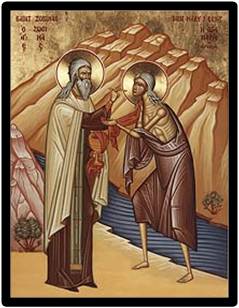MARCH 21 - ST. SERAPION

Serapion lived in Egypt during exciting times for the Church. As a young man, he received a fantastic education in Christian Theology (Religious Studies) and other important subjects. When he finished studying, for a while he directed the famous Christian school that taught catechism and the faith in Alexandria.
Then Serapion made up his mind to spend more time in prayer and penance. So he went out into the desert and became a monk. Serapion’s little rule was”The mind is purified by spiritual knowledge (or by holy meditation and prayer), the spiritual passions of the soul by charity, and the irregular appetites by abstinence and penance.”
He met the famous hermit, St. Anthony of Egypt in the desert and became his disciple. Serapion tried very hard to learn from and imitate him. When he died, Anthony left Serapion one of his cloaks, which he treasured for the rest of his life.
Serapion became bishop of Thmuis, a city in lower Egypt in the Nile delta. He went to a very important meeting of bishops in 347, called the “council of Sardis” in Sardica. Serapion was a very brave bishop. He loved the truths of the faith and tried to protect them from those who wanted to change Christian beliefs and promote Arianism.
He worked with St. Athanasius, another brave bishop. They both had great courage and became very good friends. They fought against false teachings or heresies with their homilies (preaching) and with their writings. St. Serapion was banished (sent away) from Thmuis by Emperor Constantius II who supported Arianism.
Most of St. Serapion’s writings were lost. They were letters on teachings about the faith and an explanation of the Psalms. He wrote against Macedonianism (which says that the Holy Spirit is not God) and against Manichaeism (which shows that our bodies can be used to do good or evil but that we must choose). So it is wrong to believe that only our souls are of God and that our bodies are of the devil.
His most important work, called the “Euchologion,” which was a collection of liturgical prayers, was lost for hundreds of years. It was found and published at the end of the nineteenth century.
Another famous saint of that time, Jerome, named St. Serapion a “Confessor of the Faith”. St. Serapion died around the year 370 in Egypt, in the place where he was exiled.
